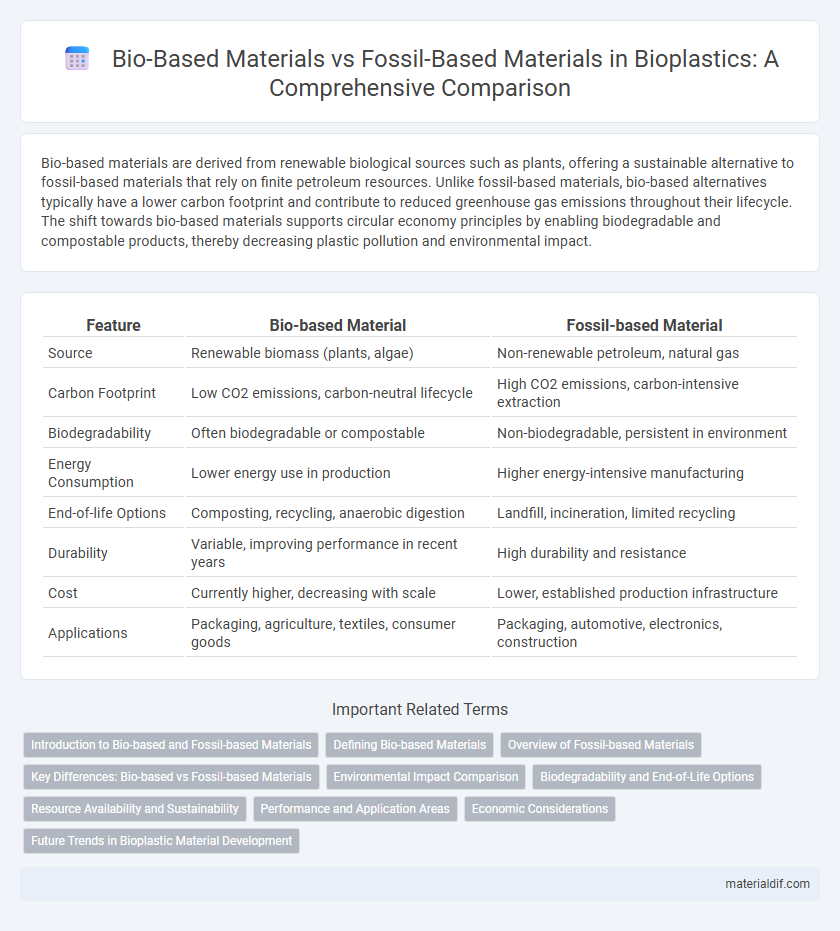Bio-based materials are derived from renewable biological sources such as plants, offering a sustainable alternative to fossil-based materials that rely on finite petroleum resources. Unlike fossil-based materials, bio-based alternatives typically have a lower carbon footprint and contribute to reduced greenhouse gas emissions throughout their lifecycle. The shift towards bio-based materials supports circular economy principles by enabling biodegradable and compostable products, thereby decreasing plastic pollution and environmental impact.
Table of Comparison
| Feature | Bio-based Material | Fossil-based Material |
|---|---|---|
| Source | Renewable biomass (plants, algae) | Non-renewable petroleum, natural gas |
| Carbon Footprint | Low CO2 emissions, carbon-neutral lifecycle | High CO2 emissions, carbon-intensive extraction |
| Biodegradability | Often biodegradable or compostable | Non-biodegradable, persistent in environment |
| Energy Consumption | Lower energy use in production | Higher energy-intensive manufacturing |
| End-of-life Options | Composting, recycling, anaerobic digestion | Landfill, incineration, limited recycling |
| Durability | Variable, improving performance in recent years | High durability and resistance |
| Cost | Currently higher, decreasing with scale | Lower, established production infrastructure |
| Applications | Packaging, agriculture, textiles, consumer goods | Packaging, automotive, electronics, construction |
Introduction to Bio-based and Fossil-based Materials
Bio-based materials are derived from renewable biological sources such as plants, algae, and microorganisms, offering a sustainable alternative to traditional fossil-based materials that originate from non-renewable petroleum and natural gas. These bio-based materials exhibit biodegradability and lower carbon footprints, contributing to reduced environmental impact compared to fossil-derived plastics. Fossil-based materials dominate current industrial applications due to their durability and cost-effectiveness but pose significant challenges including resource depletion and greenhouse gas emissions.
Defining Bio-based Materials
Bio-based materials are derived from renewable biological sources such as plants, algae, or microorganisms, contrasting with fossil-based materials that originate from non-renewable petroleum or natural gas reserves. These materials include bioplastics produced from starch, cellulose, or polylactic acid (PLA), which contribute to reducing carbon footprint and dependency on fossil fuels. Unlike fossil-based polymers, bio-based materials often offer improved biodegradability and enhanced sustainability throughout their lifecycle.
Overview of Fossil-based Materials
Fossil-based materials, derived from petroleum, natural gas, and coal, dominate global plastic production due to their high availability and cost-effectiveness. These materials, including polyethylene, polypropylene, and polystyrene, exhibit excellent durability and versatility but contribute significantly to environmental pollution and greenhouse gas emissions. The reliance on non-renewable resources makes fossil-based plastics a less sustainable option compared to bio-based alternatives.
Key Differences: Bio-based vs Fossil-based Materials
Bio-based materials are derived from renewable biological sources such as plants and algae, offering biodegradability and reduced carbon footprints, whereas fossil-based materials originate from non-renewable petroleum and natural gas, contributing to environmental pollution and higher greenhouse gas emissions. Bio-based plastics often demonstrate enhanced sustainability through lower lifecycle emissions and potential compostability, contrasting with the persistence and toxicity associated with conventional fossil-based plastics. The shift toward bio-based materials aligns with global efforts to reduce reliance on finite fossil resources and mitigate climate change impacts.
Environmental Impact Comparison
Bio-based materials in bioplastics significantly reduce carbon footprint by utilizing renewable resources such as corn and sugarcane, contrasting with fossil-based materials derived from petroleum. Lifecycle assessments demonstrate that bio-based bioplastics emit fewer greenhouse gases and contribute less to environmental pollution during production and degradation. The biodegradability and lower toxicity of bio-based materials further minimize long-term soil and water contamination compared to persistent fossil-based plastics.
Biodegradability and End-of-Life Options
Bio-based materials derived from renewable resources typically exhibit enhanced biodegradability compared to fossil-based materials, which are primarily petroleum-derived and more resistant to natural decomposition. Bioplastics made from bio-based polymers such as polylactic acid (PLA) and polyhydroxyalkanoates (PHA) offer end-of-life options including industrial composting and anaerobic digestion, reducing environmental impact. In contrast, fossil-based plastics generally require mechanical recycling or landfilling, contributing to long-term pollution and carbon emissions.
Resource Availability and Sustainability
Bio-based materials are derived from renewable resources like corn, sugarcane, and cellulose, offering a sustainable alternative to fossil-based materials that rely on finite petroleum reserves. The cultivation of bio-based feedstocks promotes carbon sequestration and reduces greenhouse gas emissions, improving overall environmental impact. Fossil-based materials, while abundant and energy-dense, contribute significantly to resource depletion and climate change due to their non-renewable nature and high carbon footprint.
Performance and Application Areas
Bio-based materials in bioplastics offer comparable mechanical strength, thermal resistance, and biodegradability to fossil-based plastics, making them suitable for packaging, agriculture, and consumer goods. Fossil-based materials typically provide higher durability and long-term stability, favored in automotive, construction, and electronics industries. The selection between bio-based and fossil-based materials depends on performance requirements such as tensile strength, barrier properties, and environmental impact within specific application areas.
Economic Considerations
Bio-based materials typically involve higher initial production costs compared to fossil-based materials due to raw material sourcing and processing complexities. However, bio-based materials offer long-term economic benefits through reduced environmental compliance expenses and potential market premiums driven by growing consumer demand for sustainable products. Investment in bio-based technology development and scale-up is a critical factor influencing cost competitiveness against fossil-based alternatives.
Future Trends in Bioplastic Material Development
Bio-based materials derived from renewable resources like corn starch, sugarcane, and cellulose are rapidly advancing to reduce reliance on fossil-based plastics made from petroleum. Emerging bioplastic innovations emphasize enhanced biodegradability, higher performance, and cost-effectiveness to meet environmental regulations and consumer demand. Future trends include integration of advanced bio-polymers such as polylactic acid (PLA) and polyhydroxyalkanoates (PHA) with improved mechanical properties and large-scale bio-refinery processes for sustainable production.
Bio-based material vs Fossil-based material Infographic

 materialdif.com
materialdif.com